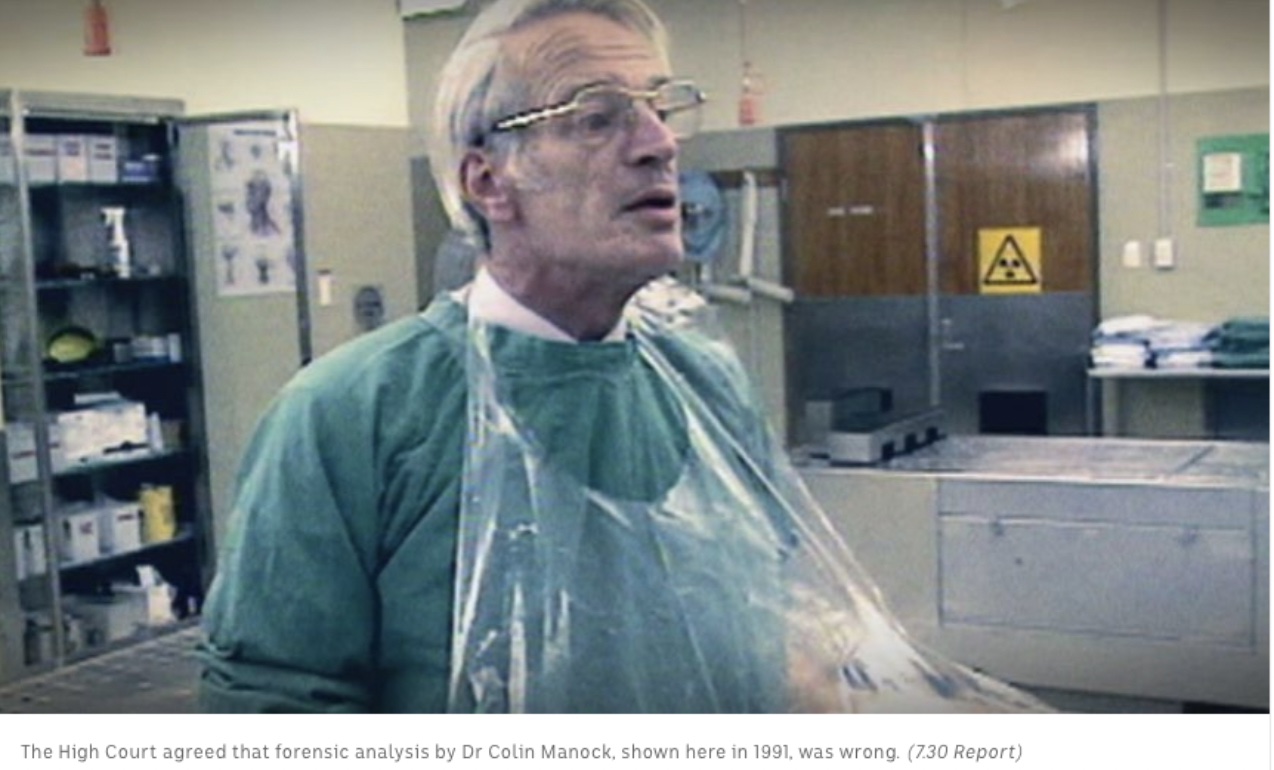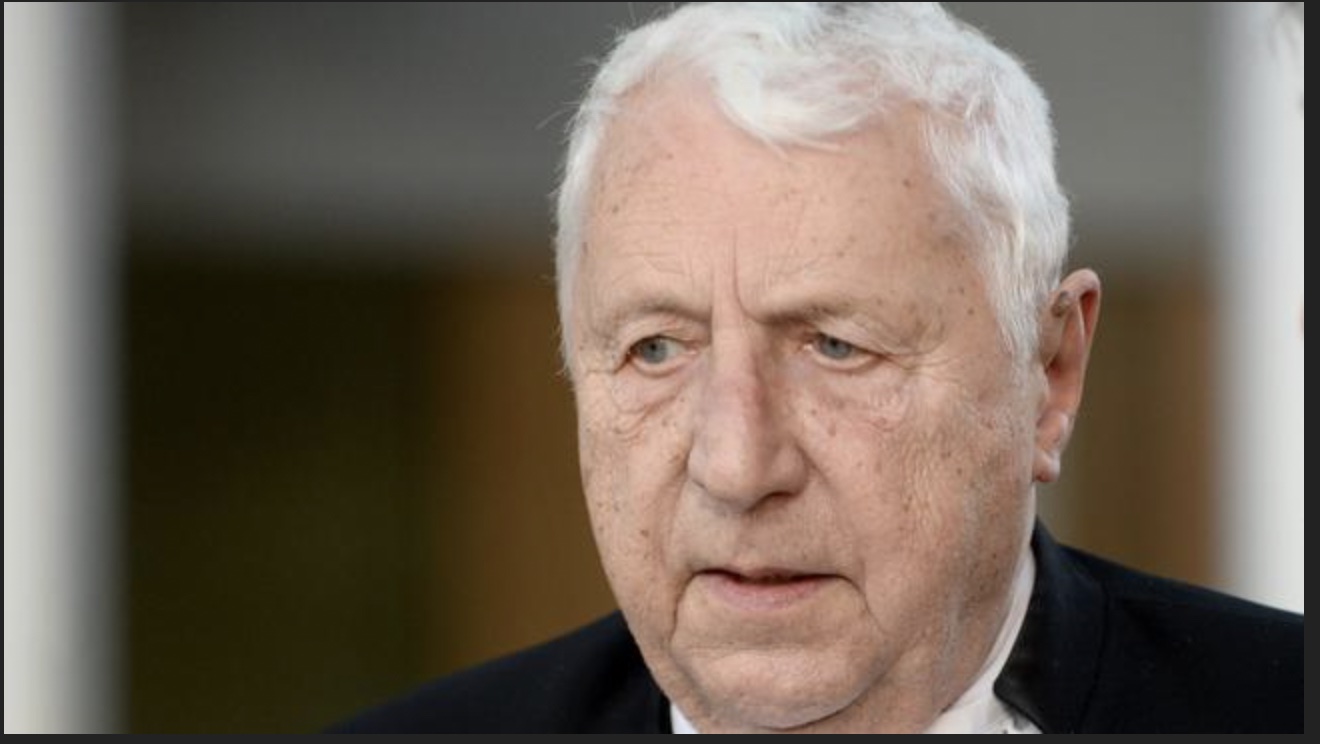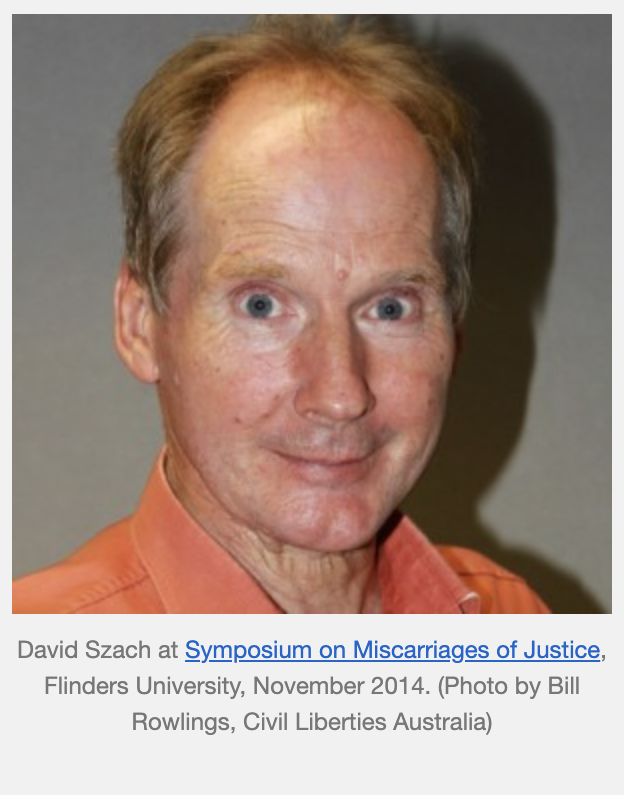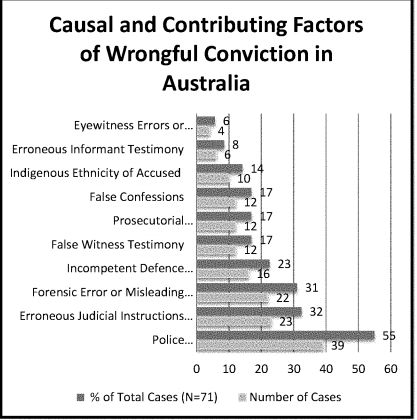Journalist Andrew L. Urban and retired barrister Kevin Borrick KC reveal how South Australia’s legal fraternity contributed to the ongoing scandal that began with the unqualified forensic pathologist Dr Colin Manock and spread like cancer, infecting the entire system. The Manock curse has corrupted justice for decades. But his were not the only crimes against forensic science … and South Australia not the only state.
The long retired Dr Colin Manock looks a little old these days, his eyes half hidden behind his spectacles. If you passed him in the street, you wouldn’t guess he once performed an autopsy in the open air. In public. It was in the main street of Mintabie, 980 kms northwest of Adelaide, the remote opal mining community (now closed). It was 1978 and an Aboriginal man had been found dead, in mysterious circumstances. The Coroner sent a team to investigate. Refusing an offer of a cool room for the procedure, the State’s forensic pathologist set up a make shift morgue in the street and proceeded to perform his gut wrenching task. After Dr Manock had removed the bodily organs from the chest, he is said to have used a ladle to scoop up some of the body fluids and to have made an ‘inappropriate remark’ – said to have been, ‘does anybody fancy a slurp?’
The report is part of a sworn affidavit by a former police officer who witnessed the event.

Dr Colin Manock
This is the Dr Colin Manock who not only lacked professional ethics; he lacked the qualifications to do his job. This is the Dr Colin Manock who described Kevin Borick KC as his bête noire and this series of articles is a record of the many reasons why, and why Borick has every reason to be proud of that description – whether Manock actually said it or not.
The chronic, long term failure of the South Australian legal system to ensure that its chief forensic pathologist was suitably qualified to give evidence was a ticking time bomb that is now exposed, with some 400 criminal cases that should be re-opened. That is the largest volume of potential wrongful convictions in a single jurisdiction – due to one pathologist – in history. And Kevin Borick KC was in the thick of it all, witnessing first hand the malpractice, incompetence and lies that allowed it to happen.
In this two-part series we present his evidence – including some matters in other jurisdictions – that reflect on the criminal justice system failing to make proper use of science.
# For nearly two and a half decades (1968 – 1995) Dr Manock was one of Australia’s leading forensic pathologists. It has been clearly established that during that whole time he was unqualified, incompetent and a liar. Yet in 2017 the High Court of Australia, dealing with an application for special leave to appeal in a case (Van Beelen) involving Dr Manock, stated they would not consider any evidence or argument relating to Dr Manock’s qualifications or his “good faith”.
# In 1992 the prosecution presented Manock to a jury at a murder trial (Keogh) as competent, qualified and credible. Shortly before that trial started the SA coroner found that the evidence presented by Manock in three murder investigations was in each case “spurious”. The prosecution did not mention those three facts to the jury even though they were aware of the findings.
# Keogh was convicted of murder. In a post trial examination of the circumstances of that trial professor Vernon Roberts informed the Solicitor General of the State of South Australia (Chris Kourakis) that Manock’s autopsy process was incompetent. When advising the government to reject Keoghs petition, Kourakis did not refer to the Vernon Roberts report.
# In the case of Drummond a prosecution forensic expert told the jury that the failure to find a DNA sample in the criminal investigation process was to be expected. She said that in the circumstances presented to her you would only expect to find a DNA sample in one out of ten cases. She later admitted that the reverse was true; you would expect to find a sample in nine out of ten cases. Drummond was convicted on the basis of the false scientific evidence and spent two years in prison. The government did not provide compensation.
# In the case of Penney the high court determined that mistakes can happen in the criminal investigation process but in effect that’s just “bad luck” for the accused.
South Australia not unique:
# In the case of Gordon Wood (NSW) a judge found that the lawyer who presented the case for the prosecution against Wood (Senior Crown Prosecutor Mark Tedeschi KC) was dishonest but, she said, he was not “deliberately dishonest” and so Wood was not entitled to compensation for his wrongful conviction.
# In the case of Susan Neill-Fraser (Tasmania), the DNA of a third party (not the accused) from the crime scene was dismissed as a ‘red herring’ by the prosecution.
# Christopher Tapp in Idaho Falls was exonerated in July 2019, thanks to evidence based on DNA and ‘genetic genealogy’ – the first such result using the revolutionary technique. He had spent 20 years in jail for the rape and murder of Angie Dodge.
# In relation to Lawyer X (lawyer and police informer Nicola Gobbo) a former Victorian DPP stated on radio national (30/7/19) that what Lawyer X and the police did has clearly damaged the reputation of the criminal “justice” system but that does not mean that miscarriages of justice occurred. That is when it is clearly established that the prosecuting authorities engaged in criminal conduct (which they did in the case of Lawyer X) in order to assist in securing a conviction, “justice” although a bit tarnished, has still been done.
FRITS VAN BEELEN – A BODY ON THE BEACH

Kevin Borick KC
“It was during this case that I first met Dr Colin Manock,” recalls Borick. “He had arrived in Australia in December 1968 from Leeds (UK). It was readily accepted that he was an expert forensic pathologist. “He wasn’t – and this series reveals how it came to be known yet ignored or overlooked by judges, lawyers and prosecutors for the best part of 30 years.
His incompetence and lack of real qualifications led to him providing evidence that underpinned the guilty verdict in this case (among many others) – yet was totally wrong. This is how it happened.
In October 1971 Frits George Van Beelen, a 25 year old carpenter with boy-next-door good looks, was charged with the July 1971 murder of 15 year old schoolgirl Deborah Leach, on Taparoo Beach in Adelaide. Following a 71 day trial in the Supreme Court of South Australia, on 19 October 1972 the jury returned a verdict of guilty – and he was sentenced to death.
There were no witnesses and the only evidence was circumstantial – and scientific, if that word isn’t too presumptuous in the circumstances. Indeed, the volume and complexity of the scientific evidence was large. After a successful appeal, a second trial was held.
At the second trial of Van Beelen, Professor Bevan was called as a witness for the defence. His evidence related to the identification of paint samples. Under cross examination Prof Bevan made the following point: “I see no reason why if the legal processes are going to use science it should not use proper science.” (sic) To that basic proposition the second proposition has been added, “and use science properly”.
On 2 October, 2017 the High Court granted special leave to Van Beelen based on the Horowitz evidence (see below). This evidence showed that “The precision of Dr Manock’s one hour interval was a critical component of the Crown case that the death had occurred no later than 4.30 pm. Professor Horowitz’s evidence has shown that Dr Manock’s one hour time period had no scientific support and was wrong.”
On 8 November 2017 the High Court found (among other things) that: Dr Manock’s opinion was based upon acceptance that there is a normal rate of gastric emptying in the human population. Kourakis CJ was right to say that Professor Horowitz’ evidence based on the results of objectively validated studies falsifies the basis for that opinion. Had the results of these studies been known at the date of the trial, Dr Manock’s opinion as to the time of Deborah’s death should not have been admitted over objection.
HENRY KEOGH – A BODY IN THE BATH

Henry Keogh
In 1995, Henry Keogh was convicted of the murder of his 29 year old fiancée Anna-Jane Cheney. They were soon to be married and on March 18, 1994, they had had a pleasant evening out. After dinner, while he went to briefly visit his mother, Anna-Jane relaxed in her bath. When he returned she was dead.
Keogh tried urgent CPR after calling the ambulance, but Anna-Jane could not be revived.
In what was a wholly circumstantial case, the prosecution had argued that Henry Keogh murdered Anna-Jane Cheney by grabbing her by the ankle as she was lying in the bath, forcing her head under water. Forensic pathologist Dr Colin Manock gave evidence that marks on her legs were grip marks that supported the prosecution hypothesis. But in 2009 Manock recanted his evidence, as noted by the judges Gray, Sulan and Nicholson JJ. “Dr Manock later acknowledged that evidence he gave at trial to the effect, at least by implication, that his microscopic examination supported the conclusion that the medial side mark was a bruise, was wrong.” (Manock had already given similar evidence before the Medical Board in 2004.)
Keogh has always protested his innocence and claimed to have not received a fair trial; he attempted to appeal several times unsuccessfully and a number of petitions of mercy, also without success.
Finally, on December 19, 2014, the Supreme Court of South Australia (Court of Criminal Appeal) agreed and his conviction was set aside, in an appeal mounted on the basis of then new further right to appeal legislation.
THE BABIES DEAN, BARNARD & NOTTLE
Known as the Baby Deaths in the legal system (and beyond), these three autopsies preceded the trial of Henry Keogh. Dr Manock’s profound mistakes (almost comical if it were not so serious) began a chain reaction of catastrophic consequences. Borick was not directly involved, but felt their impact through his involvement in the Keogh case.
In relation to the deaths of the babies Storm Deane, Billy Barnard and Joshua Nottle in 1993 and 94, the following facts are established:
Dr Manock conducted the autopsy on Storm’s body. He concluded the cause of Storm’s death was bronchopneumonia. He was wrong. His conduct of the autopsy was incompetent. In fact, Storm was bashed to death by a person, or persons unknown. As a direct result of Dr Manock’s incompetence that person or persons responsible for Storm’s death have never been held to account.
Dr Manock conducted the autopsy on Billy Barnard’s body. He concluded the cause of Billy’s death was bronchopneumonia. He was wrong again. His conduct of the autopsy was incompetent. In fact, Billy was bashed to death by a person, or persons unknown. As a direct result of Dr Manock’s incompetence that person or persons responsible for Billy’s death have never been held to account.
Dr Manock conducted the autopsy on Joshua Nottle’s body. He concluded the cause of Joshua’s death was bronchopneumonia. He was wrong yet again. His conduct of the autopsy was incompetent. In fact, Joshua was bashed to death by a person, or persons unknown. As a direct result of Dr Manock’s incompetence that person or persons responsible for Joshua’s death have never been held to account.
The Coroner further found that bronchopneumonia was not a cause of death in any of the three cases, and remarked that Dr Manock had told him at the inquest that he “was unable to recall what he saw on the slides which led him to the conclusion of bronchopneumonia”. This is in itself a comment on Dr Manock’s conduct of not properly recording his observations.
The Coroner stated: “I consider that the post-mortem examinations and reports prepared by Dr Manock in these three cases fell a long way short of achieving these aims [of a properly conducted forensic autopsy], and I am very concerned that serious crimes may have gone unpunished as a result.”
What we now have is a different explanation from Dr Manock:
“Yes, I made a misdiagnosis with the pneumonia — in fact I told the director of the forensic science centre that I found it difficult to find a cause of death, and I went through slides from previous cases, somehow one of the previous slides got mixed up with the slides from the case.”
DAVID SZACH – A BODY IN THE FREEZE
Although little known outside legal circles in South Australia, this is a perfect – or perfectly terrible – example of the importance of getting the science right in court. Defence barrister Elliott Johnston and Kevin Borick were good friends with the murdered criminal lawyer, Derrance Stevenson, and were (nevertheless) requested by the Law Society to defend the accused, David Szach.
 David Szach, 19, was in a relationship with the 44-year-old Derrance Stevenson. According to the autopsy report, Stevenson is said to have died somewhere between 4 and 5 June 1979. It appears that Szach had driven from Adelaide to Coober Pedy (about 850 kilometres north of Adelaide) on the night it was thought that Stevenson had died. Szach had originally bought a bus ticket for the journey. However, he was reimbursed for the ticket shortly before he left Adelaide, and travelled overnight to Coober Pedy in Stevenson’s rather ‘flash’ car. Police regarded this as suspicious at the time as Stevenson was said to have been possessive about his car.
David Szach, 19, was in a relationship with the 44-year-old Derrance Stevenson. According to the autopsy report, Stevenson is said to have died somewhere between 4 and 5 June 1979. It appears that Szach had driven from Adelaide to Coober Pedy (about 850 kilometres north of Adelaide) on the night it was thought that Stevenson had died. Szach had originally bought a bus ticket for the journey. However, he was reimbursed for the ticket shortly before he left Adelaide, and travelled overnight to Coober Pedy in Stevenson’s rather ‘flash’ car. Police regarded this as suspicious at the time as Stevenson was said to have been possessive about his car.
Szach was questioned by the police in Coober Pedy, and later there was some confusion about the precise timing and content of these interviews. The defence argued at the trial that the police deliberately didn’t tell Szach before the interviews that he was regarded as a suspect in the murder in the hope that he might inadvertently reveal something of value to them. It is a breach of police procedures to interview a suspect without properly informing them of their real purpose. It would, for example, be unfair to Szach if he thought that he was being interviewed on a charge of car stealing, while the police were actually trying to obtain information against him on a charge of murder. The police said that the interviews had taken place before they had received phone calls from the police in Adelaide telling them of the murder.
Szach was charged with murder and tried in the Supreme Court in Adelaide, in November and December 1979.
Stevenson’s body was found in his freezer. The pathologist, Dr Manock, calculated the time of death by utilising a formula which had been developed from experiments where bodies had been frozen in the prone position (that is, lying flat). When Stevenson’s body was found, however, it was bent round in the foetal position with his back uppermost and his arms and feet downwards.
Dr Manock said that he used the formula to calculate the time the body took to cool, adjusting the formula by 40 per cent because Stevenson’s body was doubled over rather than prone.
In those circumstances, he said, there would be a reduced surface area of the body exposed and it would therefore take longer to cool down. [In fact this is not correct – a human body bent round does not reduce the surface area – the spine would have to be hinged for that to happen.] The difficulty arises in how much the formula is to be modified. A modification of about 40 per cent can hardly be classified as an ‘adjustment’. In his autopsy report, Dr Manock stated:
“A body will cool 85 per cent of the temperature differential within 28 hours. However, where the effective surface area is reduced, the time is lengthened and in the above circumstances it is my opinion that the lengthening of cooling time would be about 40 per cent.”
Dr Manock did not provide any scientific basis for such an adjustment. This is an example of a fact being accepted into evidence on the basis of an assertion without any properly established evidence or studies to support it.
The ultimate effect of this evidence was to make Szach a plausible suspect because he was in the vicinity at the estimated time of death.
Szach has always maintained his innocence. He is hopeful that a new appeal under S353A will clear his name.
MARSHALL & WARREN – PEAK INCOMPETENCE
Dr Manock’s astonishing mistakes in the two (unrelated) cases of Marshall & Warren demonstrate the depth and breadth of his incompetence – such that it is hard to understand why he was still allowed to practice his amateurish craft on behalf the State of South Australia.
On 7 February, 1992, Bill Power of The Advertiser reported “Bungle over shooting victim”.
… a post mortem yesterday revealed that a man who police said 12 hours earlier had died of natural causes had been shot in the head. An examination by a pathologist at the death scene on Wednesday failed to find the bullet wound. Yesterday’s post mortem, carried out by the same pathologist, Dr Colin Manock, found a bullet lodged in the man’s brain.
The victim was Peter John Marshall, 35, who lived in one of three units in a block in Northcote St, Kilburn. Detective Sergeant Allan Arthur, of the major crime squad, said yesterday it would have helped investigators if the cause of death had been known on Wednesday. “Yes, the first 24 hours are crucial to an investigation,” he said.
Neighbours said Mr Marshall had lived in the unit for about 12 months and had been a leading hand at a plastics factory in the area. However, he also carried a Victorian driver’s licence, giving an address in Merbein, Victoria, which has a reputation as a major drug-growing area. Police in Mildura and Merbein said last night Mr Marshall was not known to them, and Adelaide police said it was too early to say whether Mr Marshall had been involved in the drug scene. One method of execution in the illicit drug industry is to shoot the victim in the head using a small-calibre gun.
Mr Marshall’s partly clad body was found on the bedroom floor by his sister and one of her friends when they broke into his flat on Wednesday afternoon after he had failed to answer the door. Police called to the scene said blood had come from an ear and had soaked into the carpet. At first they treated the death as suspicious but later told media organisations it appeared to be the result of natural causes.
*
Gerald Warren was an aboriginal youth whose body was found on a dirt road out from Port Augusta in 1984. Dr Manock attended the scene and later conducted the autopsy. In his report Dr Manock described injuries of fine parallel lines to the back of a hand and to the face. He thought these had been made by Warren’s corduroy trousers being pressed against his body. From this and a consideration of other injuries Dr Manock concluded that the injuries were received as the result of his body leaving or falling from a moving vehicle.
In 1991 two men separately confessed to killing Warren. The confessions came about after one of the men was by chance overheard in a pub bragging about what he had done. The person to whom he bragged happened to be an off-duty police officer. The men had in fact beaten Warren with a threaded metal rod (thus causing the fine line pattern) and then running over his body several times with their motor vehicle.
At their trial Dr Manock told the jury that being beaten with a threaded metal rod and having corduroy pressed against the skin would produce similar injuries. He said that the forces involved in falling from a moving vehicle were very similar to those involved when being run over by a vehicle. Both men were convicted of murder.
ADRIAN DRUMMOND – SCIENCE ABUSED
In this case, forensic evidence convicted and then cleared him …. eventually. Kevin Borick KC argued his appeal.
On the afternoon of November 24, 2010, at about 4.30 pm C, a female secondary school student was walking north on the eastern footpath of Prospect Road, a busy suburban Adelaide road. At about the same time, Drummond, a 29 year old man with no previous convictions, was driving home from work along Prospect Road in a northerly direction.
According to C she saw Drummond’s vehicle travelling south on Prospect Road. She saw the driver looking at her and recorded the car’s registration number in her mobile phone. It was Drummond’s registration number. She said that Drummond stopped his car, got out, and physically attacked her. She stated that she was grabbed on the top of her right arm and that it was a forceful grab and that she tried to continue walking but the man held onto her. She thought the man had mistaken her for someone else. She kept trying to walk away and heard a voice say ‘get in the car’. At this point she turned to her right to face the man. He kept saying ‘get in the car’. She described the man is being calm. As she faced the man he grabbed the top of her left arm and tried to pull her back towards the car. She then pushed forcefully against his chest with her arm. She described the level of force she used as hard and aggressive. The man stumbled backwards. She clubbed her fist and hit him around the collarbone and face two or three times. She then turned and ran north on the footpath of Prospect Road.
As she approached the junction of Prospect Road and Alpha Road, she saw the same car with the same registration number pull up next to her. She did not see the driver. She kept walking. The car did not come to a stop and travelled away as she continued to walk north on Prospect Road, she came to the junction with John’s Road and saw the vehicle pass her again and she noted that it had the same registration number. She then turned from Prospect Road into Percy Street where she met her mother.
Drummond totally denied any involvement with C. The situation described by C did not happen.
Prior to 4.30 pm o 24/11/2010 neither C or Drummond had met or had anything to do with each other. Nobody travelling on that busy road saw any such incident as described by C. Putting to one side conflicting evidence about appearance and clothing the prosecution informed the jury that C’s top was tested for his DNA and his top was tested for her DNA. There was no contact DNA that matched.
Ms Mitchell was called by the prosecution to give expert evidence. She was a forensic scientist employed by the SA government.
She told the jury a SA forensic study showed that in such a case as this there is only a 10 per cent possibility of relevant DNA samples being discovered.
Drummond’s counsel at that time, and during the subsequent appeals, had what he described as a “gripe” with that scientific evidence.
- In an affidavit filed on April 29, 2014 Mitchell accepted that contrary to her evidence at trial, the studies she referred to showed that the chance of obtaining a usable single source DNA profile from clothing may be substantially higher than 10 per cent. In general terms a more accurate figure would have been 90 per cent.
- In actual fact the studies referred to by Mitchell had “no relevance” to the interpretation of the results in these proceedings.
In his affidavit of 28 April 2014, Dr Harding# explained that Mitchell’s evidence primarily related to single source DNA profiles whereas the evidence in this proceeding relates to mixed profiles, a limitation not expressly identify in Mitchells evidence at trial. However in Dr Harding’s view Mitchell’s evidence concerning the uploading of DNA profiles to a database was irrelevant as the issue of the use of the database did not arise in the preceding.
On June 5, 2015, two of the three judges who heard Drummond’s appeal found (correctly) that the inaccurate evidence given by Mitchell resulted in a substantial miscarriage of justice. Not only was proper science not used but science was not used properly.
# Dr Harry Harding was a research fellow (bio-chemistry) at the University of Adelaide, and holds an Honours Bachelor of Science degree .
MICHAEL PENNEY – POOR INVESTIGATION IRRELEVANT
There seems to be no shortage of absurdities in the history of the law. Absurdities that should not become miscarriages of justice.
In 1996 Michael Penney was convicted of the attempted murder of his wife. The prosecution case was that on October 30, 1995 he set fire to the boot of her car just before she drove off in it.
The concern here is over the significance of a defective police investigation.
From the High Court judgement:
“It was put that there was a process which began at the inception of the investigation leading to the bringing of a charge and that a defective police investigation had so infected that trial process that the trial was not a fair trial.
There is no doubt that the police investigation was unsatisfactory in some respects, however these defects were fully exposed to the jury in cross-examination and the address to the jury by the appellant’s council. There was some reinforcement of the criticism of these defects by the accurate summary of the defence submissions to the jury by the trial judge.

Griffith University research
The appellant’s submissions on these contentions fail at the threshold. They fail because even though a better investigation may, and probably should, have been conducted, there is no general proposition of Australian law that a complete and unexceptionable investigation of an alleged crime is a necessary element of the trial process or indeed of a fair trial. That is not to give any imprimatur to incomplete, unfair or insufficient police investigations. Indeed there may be cases in which deficiencies in the investigation might be of such significance to a particular case as a whole that the accused will be entitled to an acquittal or a retrial.”
In other words, the High Court judges, including Hayne J, found that an incomplete and unexceptional investigation of an alleged crime is not a necessary element of a fair trial process. However all of the judges found that the police investigation was, to use their word, “unsatisfactory”.
That is because, to again use their words, it was “incomplete” “unfair” and “insufficient”.
Since these “defects” were exposed to the jury by the defence, the accused had a fair trial – in their opinion.
The truth is that the trial should never have been allowed to proceed. The police play a contributing or causal role in the largest percentage of cases of wrongful convictions, according to Griffith University research and forensic error is a close third (see table above).
The tragedy is that such disturbing failures of our adversarial system are so well known they are even documented for law students. For example, in the study book, Criminal Laws in NSW (The Federation Press), there is an incisive exploration of the underlying issues, in a section titled The Adversary System and the (In)Visibility of the Pre-Trial Process. In the introduction, it states: Courts have traditionally been reluctant to enforce duties of disclosure, ethical duties of fairness and otherwise ‘intervene’ in what is described as the largely discretionary accountability mechanisms which affect the conduct of the police and the prosecutorial functions.
Michael McConville, in an article written soon after the Guildford Four* were released, lucidly describes the mechanics of the British justice system that inevitably produce miscarriages of justice: … ‘the effects of many of these police decisions and practices in the pre-trial process will not be apparent to the defence or the court. It will often only be as a result of a royal commission or other official enquiry that they will come to light. The adversaries in this process command wholly unequal resources: the authority and resources of the state (primarily the police) are pitched against those of individuals of usually less than modest means. (emphasis added)
The Australian justice system demonstrates the same unfortunate characteristics.
* The Guildford Four were wrongly convicted of bombings carried out by the Provisional Irish Republican Army (IRA) on 5 October 1974.
NEXT: PART 2 – the case against a Solicitor General, a DPP and three judges

Why is Derek Bromley in Prison ? The fact that he is in Prison means what ? Is it an offence for OUR DEAR Leaders to knowingly use a Forensic Fraudster to achieve great Victories over the little citizen ? You have stated that most wrongful Convictions are the result of Police Activity – why then aren’t more Policeymens in jail ?